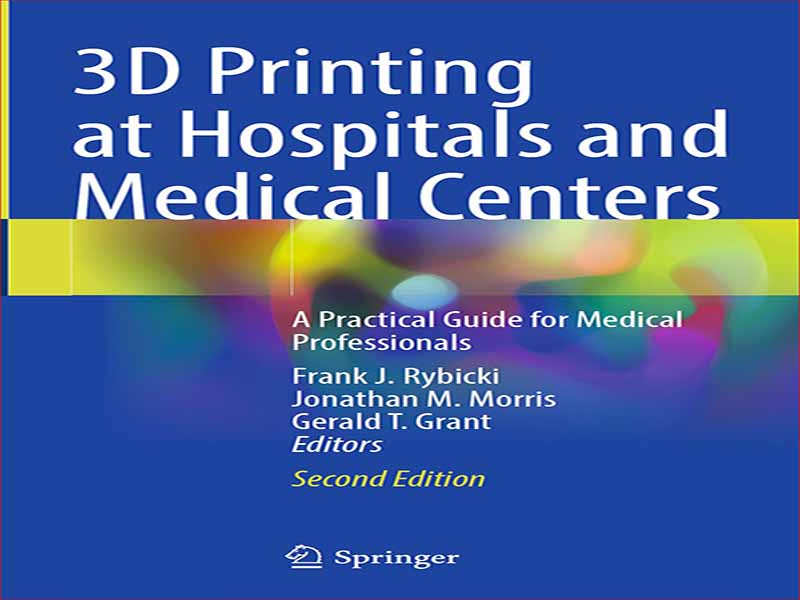- عنوان کتاب: 3D Printing at Hospitals and Medical Centers
- نویسنده: Frank J. Rybicki
- حوزه: پرینت سه بعدی
- سال انتشار: 2024
- تعداد صفحه: 396
- زیان اصلی: انگلیسی
- نوع فایل: pdf
- حجم فایل: 37.9 مگابایت
چرخه زندگی اکثر تصاویر پزشکی شامل اکتساب، تفسیر و سپس ذخیره سازی است. تفسیر به گزارش تصویربرداری (رادیولوژی) اشاره دارد. برای اکثر بیماران، ناحیه پزشکی مورد نظر طبیعی است و یک وضعیت مشکوک یا نگران کننده کنار گذاشته می شود. به عنوان مثال، اگر بیمار درد شکم داشته باشد و سی تی اسکن برای حذف آپاندیسیت انجام شود، بیشتر اوقات اسکن آپاندیس طبیعی را نشان می دهد. سوالات- 1 در این کتاب من از اصطلاح “رادیولوژی” و “رادیولوژیست” برای اشاره به تصویربرداری و شخصی که تصویربرداری را انجام می دهد استفاده می کنم. متخصصان قلب، تصویربرداری را انجام و تفسیر می کنند. من در تصویربرداری قلب و عروق کار می کنم، و بسیاری از متخصصان قلب را آموزش داده ام. موفقیت جمعی آنها در تصویربرداری و پرینت سه بعدی، باعث افتخار من است. بنابراین، درخواست من در ابتدای کتاب این است که از “رادیولوژی” و “رادیولوژیست” به طور کلی استفاده کنید. یعنی “گزارش رادیولوژی” ممکن است توسط متخصص قلب ایجاد شود. در برخی موارد، من فصلها را به شدت ویرایش نکردهام و ممکن است از «تصویربرداری قلبی عروقی» و «تصویرساز قلب و عروق» استفاده شود. همین امر در مورد دندانپزشکان که CT پرتو مخروطی را در عمل خود گنجانده و تفسیر می کنند صادق است. در این مورد، داده ها برای تفسیر و چاپ سه بعدی پزشکی کاملاً خارج از بخش رادیولوژی به دست می آید. پاسخ داده شده است و بسیاری از علل دیگر درد شکم نیز ممکن است کنار گذاشته شوند. برای این بیمار فرضی، حتی اگر تصاویر حاوی دادههای اضافی فراوانی باشند، این دادهها بیاهمیت هستند. برای بیماران مبتلا به بیماری پیچیده، خواه ناهنجاری های آناتومی یا فیزیولوژیکی باشد، تصاویر پزشکی حاوی داده های اضافی است که معمولاً در گزارش تصویربرداری سنتی ثبت نمی شود. با این حال، این داده ها می توانند و باید برای مراقبت از بیمار استخراج شوند. حرفه من در بوستون به عنوان دانشجو و سپس عضو آزمایشگاه برنامه ریزی جراحی در بیمارستان بریگهام و زنان زیر نظر فرنک جولز و رون کیکینیس آغاز شد. تفکر درخشان آنها ابتدا با 3D Slicer (slicer.org) [1] و سپس به عنوان یک رادیولوژیست جوان با تصویربرداری قلب و عروق و بازسازی جمجمه فک و صورت و سپس با طراحی به کمک کامپیوتر (CAD) و سپس با دینامیک سیالات محاسباتی (CFD) مورد توجه من قرار گرفت. و در نهایت با پرینت سه بعدی قطعات فیزیکی. این کتاب این تجربیات را فشرده می کند تا بررسی کند که مهندسان و ارائه دهندگان چگونه تصاویر رادیولوژی را برای مراقبت بهتر از بیمار دستکاری می کنند، و به ویژه هنگامی که از چاپ سه بعدی در بیمارستان به عنوان تحقق خاص بیمار از کار خود استفاده می کنند. این ویرایش دوم مفصلتر و جامعتر از ویرایش اول است و امیدوارم که مرجع ارزشمندی در این زمینه باشد.
The life cycle for most medical images includes acquisition, interpretation, and then storage. Interpretation refers to the imaging (radiology) report.1 For most patients, the medical region of interest is normal, and a suspected or worrisome condition is excluded. For example, if a patient has abdominal pain and a CT scan is performed to exclude appendicitis, more often than not the scan demonstrates a normal appendix. The ques- 1 In this book I use the term “radiology” and “radiologist” to refer to the imaging and the person who performs the imaging. Cardiologists perform and interpret imaging. I work in cardiovascular imaging, and I have trained many cardiologists; their collective success in imaging, and in 3D printing, makes me incredibly proud. So, my request at the onset of the book is to use “radiology” and “radiologist” generically. That is, the “radiology report” may be generated by a cardiologist. In some cases, I have not strictly edited chapters, and “cardiovascular imaging” and “cardiovascular imager” may be used. The same is true for dentists who incorporate and interpret cone beam CT in their practice. In this case, data for interpretation and for medical 3D printing is acquired entirely outside of a radiology department. tion is answered, and many other causes of abdominal pain may also be excluded. For this hypothetical patient, even though the images contain an abundance of additional data, that data is inconsequential. For patients with complex disease, whether it be an abnormality of anatomy or physiology, medical images hold additional data that is not typically captured in a traditional imaging report. However, that data can and should be extracted for patient care. My career was launched in Boston as a student and then member of the Surgical Planning Lab at Brigham and Women’s Hospital under the mentorship of Ferenc Jolesz and Ron Kikinis. Their brilliant thinking became my tinkering, first with 3D Slicer (slicer.org) [1], and then as a junior radiologist with cardiovascular imaging and craniomaxillofacial reconstruction, and then with Computer Aided Design (CAD) followed by Computational Fluid Dynamics (CFD), and finally with 3D printing physical parts. This book condenses those experiences to survey how engineers and providers manipulate radiology images for better patient care, and in particular when they use in-hospital 3D printing as the Patient Specific Realization of their work. This second edition is more detailed and more comprehensive than the first edition, and I hope that it proves to be a valuable reference in the field.
این کتاب را میتوانید بصورت رایگان از لینک زیر دانلود نمایید.





































نظرات کاربران